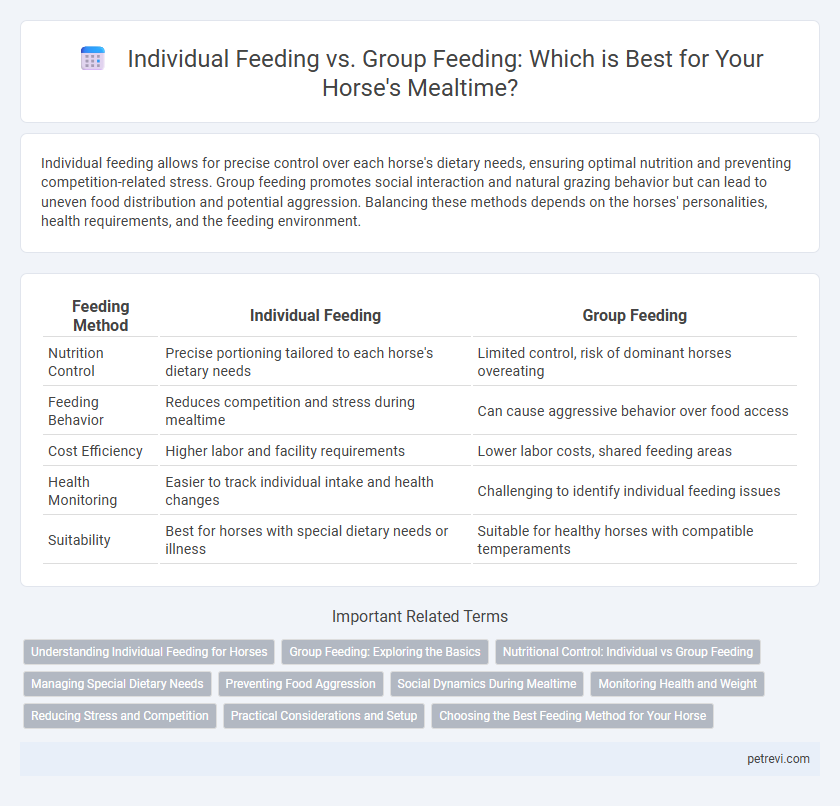Individual feeding allows for precise control over each horse's dietary needs, ensuring optimal nutrition and preventing competition-related stress. Group feeding promotes social interaction and natural grazing behavior but can lead to uneven food distribution and potential aggression. Balancing these methods depends on the horses' personalities, health requirements, and the feeding environment.
Table of Comparison
| Feeding Method | Individual Feeding | Group Feeding |
|---|---|---|
| Nutrition Control | Precise portioning tailored to each horse's dietary needs | Limited control, risk of dominant horses overeating |
| Feeding Behavior | Reduces competition and stress during mealtime | Can cause aggressive behavior over food access |
| Cost Efficiency | Higher labor and facility requirements | Lower labor costs, shared feeding areas |
| Health Monitoring | Easier to track individual intake and health changes | Challenging to identify individual feeding issues |
| Suitability | Best for horses with special dietary needs or illness | Suitable for healthy horses with compatible temperaments |
Understanding Individual Feeding for Horses
Individual feeding for horses ensures precise control over each horse's diet, catering to specific nutritional needs and health conditions. This method minimizes competition and stress during mealtime, promoting better digestion and overall well-being. Understanding individual feeding helps optimize nutrient intake, prevent overfeeding or underfeeding, and supports targeted supplementation.
Group Feeding: Exploring the Basics
Group feeding for horses promotes natural herd behavior, reducing stress and encouraging social interaction during mealtime. It requires careful management of feed distribution and space to prevent bullying and ensure all horses receive adequate nutrition. Implementing group feeding systems can improve overall well-being and streamline feeding routines on equine facilities.
Nutritional Control: Individual vs Group Feeding
Individual feeding allows precise control over each horse's nutritional intake, ensuring tailored diets that meet specific health needs and prevent overfeeding or nutrient deficiencies. Group feeding risks unequal consumption, as dominant horses may monopolize food while subordinate ones receive insufficient nutrients, leading to imbalanced growth and health issues. Monitoring feed quantities and adjusting rations individually optimize performance, digestion, and overall equine well-being.
Managing Special Dietary Needs
Individual feeding allows precise control over a horse's special dietary needs, ensuring tailored nutrient intake and preventing competition for food. Group feeding can lead to uneven consumption, where dominant horses may consume more, risking deficiencies or excesses in others. Managing specific dietary requirements like allergies or supplements is more effective with individual feeding routines.
Preventing Food Aggression
Individual feeding for horses significantly reduces the risk of food aggression by minimizing competition and stress during mealtime. Separate feeding stations ensure each horse has adequate access to food, helping maintain a calm environment and preventing injuries. Group feeding often leads to dominant horses monopolizing resources, increasing anxiety and aggressive behavior among herd members.
Social Dynamics During Mealtime
Individual feeding allows horses to eat without competition, reducing stress and preventing dominant individuals from monopolizing food. Group feeding promotes natural herd behaviors, fostering social bonds but can lead to aggression or resource guarding among lower-ranking horses. Understanding social dynamics during mealtime is essential for optimizing feeding strategies that support both nutritional needs and herd harmony.
Monitoring Health and Weight
Individual feeding allows precise monitoring of each horse's food intake and weight changes, essential for detecting early health issues. Group feeding can complicate tracking consumption, increasing the risk of unnoticed nutritional imbalances or weight fluctuations. Implementing separate feeding stations with clear monitoring protocols ensures accurate assessment of each horse's dietary needs and overall health.
Reducing Stress and Competition
Individual feeding minimizes competition and reduces stress by allowing horses to eat at their own pace without interference from dominant animals. Group feeding can lead to aggressive behavior and uneven food intake, increasing anxiety and the risk of injury. Implementing separated feeding stations or timed feeding schedules ensures equitable nutrition and promotes overall herd harmony.
Practical Considerations and Setup
Individual feeding allows precise control over each horse's dietary intake, essential for managing weight, health conditions, and nutritional needs. Group feeding requires careful space allocation and multiple feeding stations to minimize competition and aggression among horses. Proper setup with sturdy feeders, ample space, and routine monitoring ensures efficient feeding while maintaining horse welfare in both scenarios.
Choosing the Best Feeding Method for Your Horse
Individual feeding ensures precise control over your horse's diet, preventing competition and monitoring intake of specific nutrients like hay, grains, and supplements. Group feeding promotes natural social behaviors and reduces labor, but risks uneven consumption and potential dominance-related stress. Selecting the best feeding method depends on your horse's health, behavior, and nutritional needs, prioritizing both physical well-being and mental comfort.
Individual Feeding vs Group Feeding for Horse Mealtime Infographic

 petrevi.com
petrevi.com